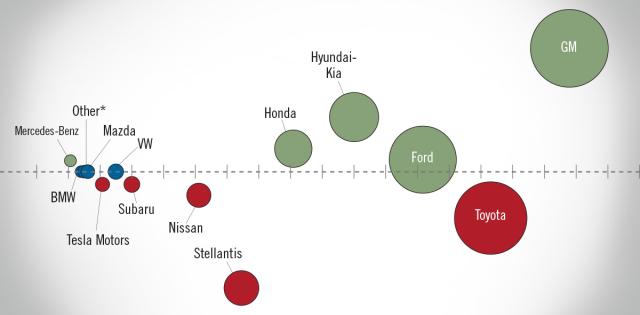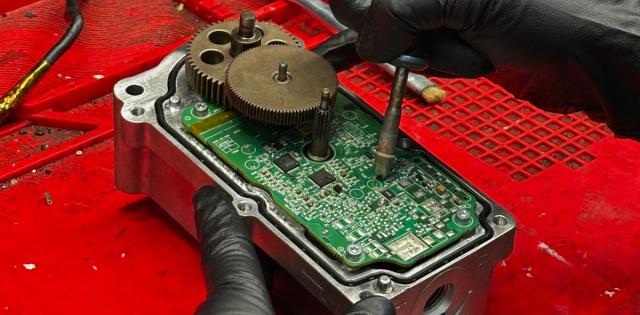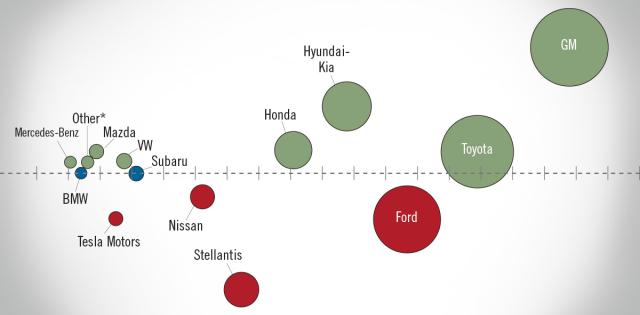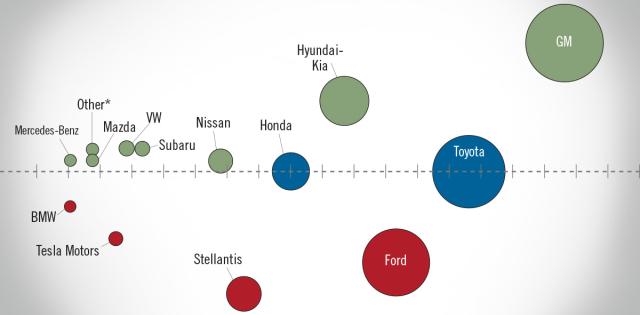The article below is sourced from Bloomberg Wire Service. The views and opinions expressed in this story are those of the Bloomberg Wire Service and do not necessarily reflect the official policy or position of NADA.
General Motors Co. raised its profit target for the year by at least $1 billion and said its second-quarter earnings beat analysts estimates on stronger-than-expected US sales, especially its largest and most profitable models.
The results show that while investors eagerly await progress in GM’s electric-vehicle program, its legacy business making gasoline and diesel-fueled SUVs and trucks are allowing it to crank out big profits. Consumers are buying the thirstiest and most expensive models despite rising interest rates and elevated sticker prices.
“The biggest driving force behind our financial results is customer demand for our vehicles,” GM Chief Executive Officer Mary Barra said Tuesday in a letter to shareholders. “We have earned four consecutive quarters of higher retail market share in the US.”
The Detroit automaker projected 2023 earnings before interest and taxes to reach between $12 billion and $14 billion, compared to its previous guidance that peaked at $13 billion. GM also forecast earnings per share for the full year of between $7.15 and $8.15, up from a maximum of $7.35 a share previously.
Shares of the company rose 1.9% in premarket trading Tuesday as of 7:30 a.m. in New York after an earlier spike as high as 3.2%. The stock closed Monday up about 17% so far this year.
GM also raised its net income outlook for 2023 to $9.3 billion to $10.7 billion, compared to the previous guidance of $8.4 billion to $9.9 billion.
Barra said the bullish full-year guidance assumes no labor strike this year. GM has kicked off discussions for a new contract with the United Auto Workers union ahead of a Sept. 14 deadline. The talks are expected to be contentious.
GM said the second consecutive upward revision in GM’s 2023 profit forecast was also made possible in part by reductions in capital spending, which will be in the range of $11 billion to $12 billion.
The company had targeted $2 billion in reduced costs this year and in 2024, and has identified another $1 billion in cuts beyond that, GM Chief Financial Officer Paul Jacobson said on a call with reporters.
The automaker is concentrating investment on its most strategic internal combustion engine and EV programs, Barra said, as well as its most promising growth initiatives, including Cruise LLC, its self-driving car unit, as well as its BrightDrop EV fleet and software-defined vehicles.
Cruise lost $611 million in the quarter and the driverless car business has cost GM $1.2 billion so far this year.
Higher revenue drove up profits in the most recent quarter. GM’s $44.8 billion tally surpassed analyst expectations of $42.8 billion — and came in well ahead of $35.8 billion a year ago. Adjusted earnings per share came to $1.91 for the three months to June 30, above the consensus estimate of $1.86.
Bolt Recall Charge
GM’s second quarter earnings would have been even higher if not for a $792 million charge related to the 2021 recall of its Chevrolet Bolt electric vehicle. The company said it is reimbursing South Korean partners LG Electronics and LG Energy Solution for part of the original $1.9 billion in recall costs. GM had to recall every one of the 142,000 Bolts that had been sold at that time because of a rare defect that could result in the battery catching on fire.
The carmaker’s North American business unit reported a 39% jump in operating profit to $3.2 billion, while it moved into the black in China, making $78 million in the quarter after losing $87 million in its second-largest market a year ago.
One factor in GM’s improved profit was vehicle pricing. Jacobson said average transaction prices rose $1,600 over the first quarter of this year and incentives remain minimal.
“We have the ability and capacity to remain disciplined with pricing,” he said. “Our competition has been moving pricing around a lot.”
Jacobson said GM will be able to produce 100,000 electric vehicles in the second half of this year after making half that many in the first half. The company’s joint venture with LG Energy Solution is boosting production at its plant in Ohio in the second half of the year.
For more stories like this, bookmark www.NADAheadlines.org as a favorite in the browser of your choice and subscribe to our newsletter here:










